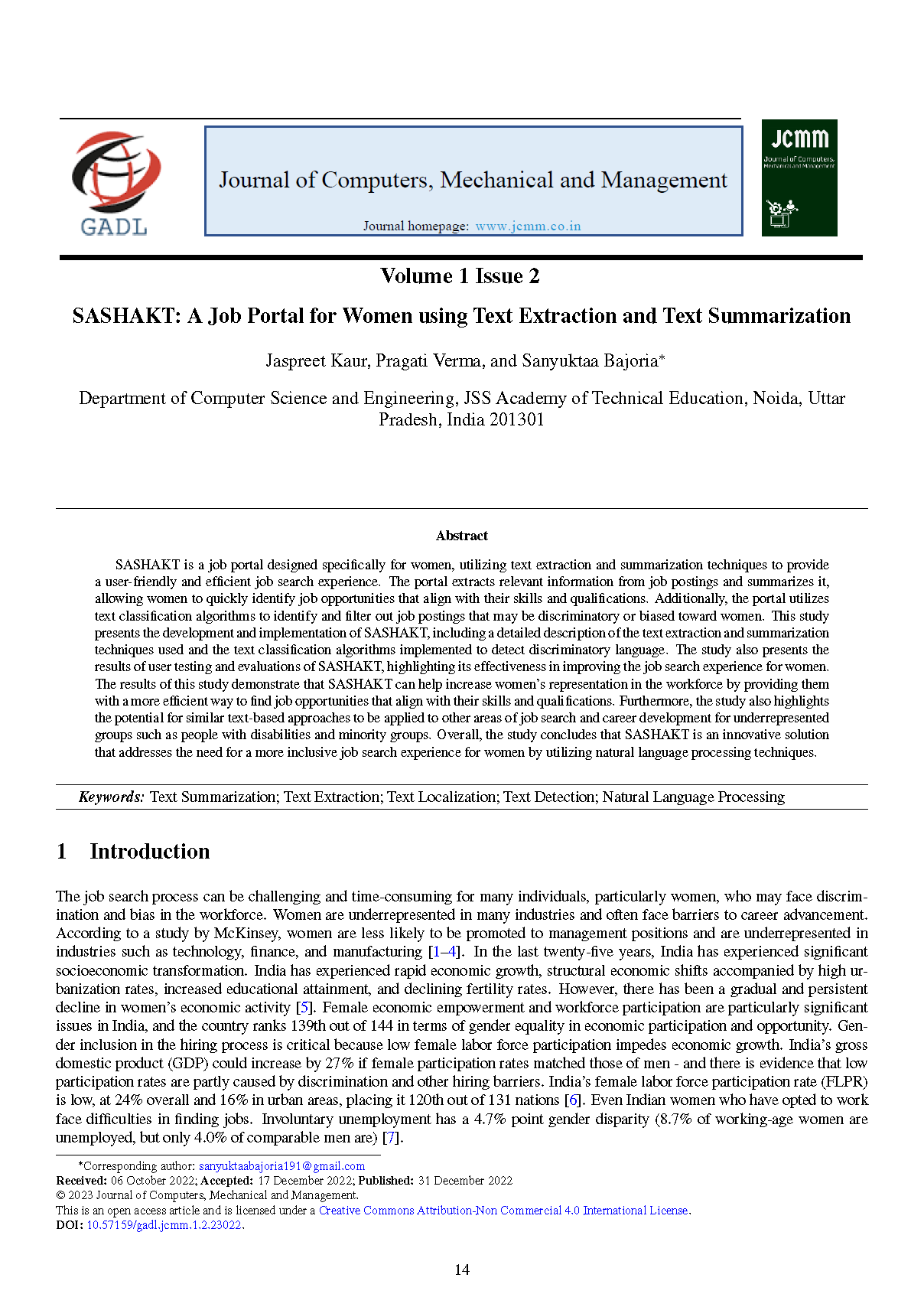SASHAKT
A Job Portal for Women using Text Extraction and Text Summarization
DOI:
https://doi.org/10.57159/gadl.jcmm.1.2.22022Keywords:
Text summarization, Text extraction, Text localization, Text detection, Natural language processingAbstract
SASHAKT is a job portal designed specifically for women, utilizing text extraction and summarization techniques to provide a user-friendly and efficient job search experience. The portal extracts relevant information from job postings and summarizes it, allowing women to quickly identify job opportunities that align with their skills and qualifications. Additionally, the portal utilizes text classification algorithms to identify and filter out job postings that may be discriminatory or biased toward women. This study presents the development and implementation of SASHAKT, including a detailed description of the text extraction and summarization techniques used and the text classification algorithms implemented to detect discriminatory language. The study also presents the results of user testing and evaluations of SASHAKT, highlighting its effectiveness in improving the job search experience for women. The results of this study demonstrate that SASHAKT can help increase women's representation in the workforce by providing them with a more efficient way to find job opportunities that align with their skills and qualifications. Furthermore, the study also highlights the potential for similar text-based approaches to be applied to other areas of job search and career development for underrepresented groups such as people with disabilities and minority groups. Overall, the study concludes that SASHAKT is an innovative solution that addresses the need for a more inclusive job search experience for women by utilizing natural language processing techniques.
References
M. L. Johns, Breaking the glass ceiling: structural, cultural, and organizational barriers preventing women from achieving senior and executive positions., “Perspectives in health information management,” 10 (Winter), 2013.
K. Yanosek, D. Abramson, and S. Ahmad, How women can help fill the oil and gas industry’s talent gap, “McKinsey & Company,” pp. 1–11, 2019.
D. Barton, J. Woetzel, J. Seong, and Q. Tian, Artificial intelligence: implications for China, “McKinsey Global Institute,” Discussion (April), p. 20, 2017.
N. Waller, How men and women see the workplace differently, “The Wall Street Journal,” pp. 1–2, 2016.
R. Lahoti and H. Swaminathan, Economic development and women’s labor force participation in India, “Feminist Economics,” 22 (2), pp. 168–195, 2016, doi: https://doi.org/10.1080/13545701.2015.1066022.
L. Narayan, Women’s labour force participation in Haryana: a disaggregated analysis, “Imperial Journal of Interdisciplinary Research,” 2 (11), 2016.
A. Ghazala, M. Guell, and A. Manning, Gender Gaps in Unemployment Rates in OECD countries, “Journal of Labor Economics,” 24 (1), pp. 1–37, 2006.
E. Fletcher, R. Pande, and C. M. T. Moore, Women and work in india: descriptive evidence and a review of potential policies, “SSRN Electronic Journal,” 2017, doi: https://doi.org/10.2139/ssrn.3116310.
A. L. Beckwith PhD, D. R. Carter DM, and T. Peters PhD, The Underrepresentation of African American women in executive leadership: what’s getting in the way?, “Journal of Business Studies Quarterly,” 7 (4), pp. 115–134, 2016.
J. R. Cohen, D. W. Dalton, L. L. Holder-Webb, and J. J. McMillan, An analysis of glass ceiling perceptions in the accounting profession, “Journal of Business Ethics,” 164 (1), pp. 17–38, 2020, doi: https://doi.org/10.1007/s10551-018-4054-4.
M. M. Henley, Women’s success in academic science: challenges to breaking through the ivory ceiling, “Sociology Compass,” 9 (8), pp. 668–680, 2015, doi: https://doi.org/10.1111/soc4.12291.
J. K. Pinto, P. Patanakul, and M. B. Pinto, “The aura of capability”: Gender bias in selection for a project manager job, “International Journal of Project Management,” 35 (3), pp. 420–431, 2017, doi: https://doi.org/10.1016/j.ijproman.2017.01.004.
C. Ashcraft, B. Mclain, and E. Eger, Women in Tech: The Facts. 2016.
N. Kumari and P. Singh, Text summarization and its types, 2021, pp. 368–378. doi: https://doi.org/10.4018/978-1-7998-4730-4.ch017.
A. Nenkova and K. McKeown, A survey of text summarization techniques, in Mining Text Data, Boston, MA: Springer US, 2012, pp. 43–76. doi: https://doi.org/10.1007/978-1-4614-3223-4_3.
R. Parimoo, R. Sharma, N. Gaur, N. Jain, and S. Bansal, A review on text summarization techniques, “International Journal for Research in Applied Science and Engineering Technology,” 10 (5), pp. 871–873, 2022, doi: https://doi.org/10.22214/ijraset.2022.42358.
F. Zhang, H. Fleyeh, X. Wang, and M. Lu, Construction site accident analysis using text mining and natural language processing techniques, “Automation in Construction,” 99, pp. 238–248, 2019, doi: https://doi.org/10.1016/j.autcon.2018.12.016.
T. Pranckevičius and V. Marcinkevičius, Comparison of naive bayes, random forest, decision tree, support vector machines, and logistic regression classifiers for text reviews classification, “Baltic Journal of Modern Computing,” 5 (2), 2017, doi: https://doi.org/10.22364/bjmc.2017.5.2.05.

Downloads
Published
How to Cite
Issue
Section
License
Copyright (c) 2022 Journal of Computers, Mechanical and Management

This work is licensed under a Creative Commons Attribution-NonCommercial 4.0 International License.
The Journal of Computers, Mechanical and Management applies the CC Attribution- Non-Commercial 4.0 International License to its published articles. While retaining copyright ownership of the content, the journal permits activities such as downloading, reusing, reprinting, modifying, distributing, and copying of the articles, as long as the original authors and source are appropriately cited. Proper attribution is ensured by citing the original publication.





